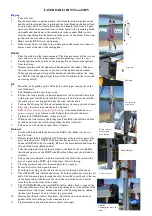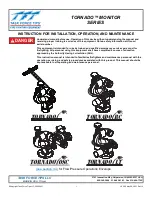
LASER BAHIA HINTS and TIPS
Rudder
1.
Place the rudder on the transom mount. The long pin comes all the way out
(but you have to move the rudder uphaul and downhaul ropes out of the way.)
2.
Put the split pin in the bottom of the long pin. Do not remove the split pin
from the string.
3.
Become familiar with the uphaul and downhaul for the rudder. When on
the water loosen the wing nut so you can use the uphaul and downhaul.
When in deep enough water pull the downhaul, and then tighten the wing
nut. NOTE: with the uphaul tight there will be NO rudder in the water, and
no steering ability!
Jib
1.
Raise the jib by pulling on the Jib halyard (white rope) coming out of the
rear of the mast.
2.
Pull through until the wire loop is seen.
3.
Put the wire loop onto the jib halyard purchase system (red and white rope
with hook) note that the hook should be facing aft, and also make sure that
the white rope is not trapped between the wire and the hook.
4.
Tension the jib using the jib halyard purchasing system on port side of mast.
5.
Tidy away the white rope into the halyard pocket.
6.
REMOVE the forestay from the Jib Tack bar
at the front of the boat
(see
picture overpage by jib)
and fasten to the P clip at the bottom of the mast.
7.
Tighten the LOWER Shrouds, if they are loose.
8.
When on the water release the furling line (Thin Red with yellow and blue
on stbd deck) from the cleat before pulling the blue jib sheets.
9.
Pull on one of the jib sheets (pure blue) to unfurl.
Mainsail
1.
Put the rolled mainsail in the boat on the PORT side. Make sure boat is
head to wind.
2.
Release the main halyard (Black & White rope) from the lower part of the
mast on the Port side. NOTE: if the boat has been put away correctly the
boom will DROP, so do it carefully. Retrieve the main halyard end from the
aft end of the boom (Black bobble).
3.
Take the main halyard forward and attach to the head of the sail. Bobble
should end up also on the PORT side. Mast head buoyancy should also be
attached.
4.
Pull on the main halyard while the crew feeds the luff of the sail into the
groove, again on the PORT side of the Gnav. Hoist to the top.
5.
Cleat the mainsail, and stow the main halyard in a pocket.
6.
Secure the Velcro tack around the mast.
7.
Feed the plastic slug on the sail into the cut-out in the top of the boom.
8.
The OUTHAUL line is Black and Green. Take the outhaul line from the aft
end of the boom and pass through the clew from stbd to port back to the rear
of the boom and put the knot in the slot at the end of the boom. Control
from the cleat at the front of the boom.
9.
The CUNNINGHAM is the small RED (yellow &blue flecks) rope on the
stbd side of the mast. Pass the loose end up through eye at the bottom of the
mainsail from stbd to port. Anchor the end of the Cunningham by sliding
the knot into the mast track just below the gooseneck.
10.
Reefing line (Black –yellow blue fleck) Should be stowed on the front
pocket of the sail on the port side when not in use.
11.
Tighten kicker to required tension on centre of cockpit.
Rigging
1.
Take off cover
2.
Rig the main sheet as per the picture. Start from the forward pulley on the
handle with the stopper knot, up through the front block on the boom (feed
back to front) down to same forward block on handle (feed front to back),
up to rear block on boom (feed front to back) down to the remaining block
on handle and then down to the main block in the cockpit. Make sure to
feed the rope through in the direction of the arrow on the block. Put a stop-
per knot on the free end of the main sheet.
3.
Make sure the BUNG is in, on transom.
4.
If the reefing line is attached to the rudder plate undo (make sure there re-
mains a knot at the end of the reefing line).
Split pin
Long pin
Hook, keep
rope clear
P Clip on mast
Or tie round
mast thwart
Main Halyard
Velcro to mast
Outhaul
Cunningham, knot in
track
1
2
3
4
Rear
Front




















